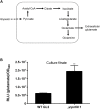Cpn60.1 (GroEL1) Contributes to Mycobacterial Crabtree Effect: Implications for Biofilm Formation
- PMID: 31244785
- PMCID: PMC6579834
- DOI: 10.3389/fmicb.2019.01149
Cpn60.1 (GroEL1) Contributes to Mycobacterial Crabtree Effect: Implications for Biofilm Formation
Abstract
Biofilm formation is a survival strategy for microorganisms facing a hostile environment. Under biofilm, bacteria are better protected against antibacterial drugs and the immune response, increasing treatment difficulty, as persistent populations recalcitrant to chemotherapy are promoted. Deciphering mechanisms leading to biofilms could, thus, be beneficial to obtain new antibacterial drug candidates. Here, we show that mycobacterial biofilm formation is linked to excess glycerol adaptation and the concomitant establishment of the Crabtree effect. This effect is characterized by respiratory reprogramming, ATP downregulation, and secretion of various metabolites including pyruvate, acetate, succinate, and glutamate. Interestingly, the Crabtree effect was abnormal in a mycobacterial strain deficient for Cpn60.1 (GroEL1). Indeed, this mutant strain had a compromised ability to downregulate ATP and secreted more pyruvate, acetate, succinate, and glutamate in the culture medium. Importantly, the mutant strain had higher intracellular pyruvate and produced more toxic methylglyoxal, suggesting a glycolytic stress leading to growth stasis and consequently biofilm failure. This study demonstrates, for the first time, the link between mycobacterial biofilm formation and the Crabtree effect.
Keywords: Crabtree effect; GroEL1; biofilm; metabolic adaptation; methylglyoxal; mycobacteria.
Figures








Similar articles
-
The Mycobacterium bovis BCG GroEL1 Contributes to Isoniazid Tolerance in a Dormant-Like State Model.Microorganisms. 2023 Jan 21;11(2):286. doi: 10.3390/microorganisms11020286. Microorganisms. 2023. PMID: 36838252 Free PMC article.
-
GroEL1: a dedicated chaperone involved in mycolic acid biosynthesis during biofilm formation in mycobacteria.Cell. 2005 Dec 2;123(5):861-73. doi: 10.1016/j.cell.2005.09.012. Cell. 2005. PMID: 16325580
-
Mycobacteria produce proteins involved in biofilm formation and growth-affecting processes.Acta Microbiol Immunol Hung. 2018 Aug 1;65(3):405-418. doi: 10.1556/030.65.2018.033. Epub 2018 Jul 19. Acta Microbiol Immunol Hung. 2018. PMID: 30024267
-
The extracellular matrix of mycobacterial biofilms: could we shorten the treatment of mycobacterial infections?Microb Cell. 2019 Jan 18;6(2):105-122. doi: 10.15698/mic2019.02.667. Microb Cell. 2019. PMID: 30740456 Free PMC article. Review.
-
Mycobacterium biofilms: factors involved in development, dispersal, and therapeutic strategies against biofilm-relevant pathogens.Crit Rev Eukaryot Gene Expr. 2014;24(3):269-79. doi: 10.1615/critreveukaryotgeneexpr.2014010545. Crit Rev Eukaryot Gene Expr. 2014. PMID: 25072151 Review.
Cited by
-
The Mycobacterium bovis BCG GroEL1 Contributes to Isoniazid Tolerance in a Dormant-Like State Model.Microorganisms. 2023 Jan 21;11(2):286. doi: 10.3390/microorganisms11020286. Microorganisms. 2023. PMID: 36838252 Free PMC article.
-
Histidine-Rich C-Terminal Tail of Mycobacterial GroEL1 and Its Copper Complex─The Impact of Point Mutations.Inorg Chem. 2023 May 8;62(18):6893-6908. doi: 10.1021/acs.inorgchem.2c04486. Epub 2023 Apr 24. Inorg Chem. 2023. PMID: 37092705 Free PMC article.
-
Telacebec Interferes with Virulence Lipid Biosynthesis Protein Expression and Sensitizes to Other Antibiotics.Microorganisms. 2023 Sep 30;11(10):2469. doi: 10.3390/microorganisms11102469. Microorganisms. 2023. PMID: 37894127 Free PMC article.
-
Mycobacterial Biofilm: Mechanisms, Clinical Problems, and Treatments.Int J Mol Sci. 2024 Jul 16;25(14):7771. doi: 10.3390/ijms25147771. Int J Mol Sci. 2024. PMID: 39063012 Free PMC article. Review.
-
Antimycobacterial Activities of Hydroxamic Acids and Their Iron(II/III), Nickel(II), Copper(II) and Zinc(II) Complexes.Microorganisms. 2023 Oct 23;11(10):2611. doi: 10.3390/microorganisms11102611. Microorganisms. 2023. PMID: 37894269 Free PMC article.
References
-
- Ahmed N., Thornalley P. J., Dawczynski J., Franke S., Strobel J., Stein G., et al. (2003). Methylglyoxal-derived hydroimidazolone advanced glycation end-products of human lens proteins. Invest. Ophthalmol. Vis. Sci. 44 5287–5292. - PubMed
-
- Astarie-Dequeker C., Le Guyader L., Malaga W., Seaphanh F. K., Chalut C., Lopez A., et al. (2009). Phthiocerol dimycocerosates of M. tuberculosis participate in macrophage invasion by inducing changes in the organization of plasma membrane lipids. PLoS Pathog. 5:e1000289. 10.1371/journal.ppat.1000289 - DOI - PMC - PubMed
-
- Aya Castaneda Mdel R., Sarnacki S. H., Noto Llana M., Lopez Guerra A. G., Giacomodonato M. N., Cerquetti M. C. (2015). Dam methylation is required for efficient biofilm production in Salmonella enterica serovar Enteritidis. Int. J. Food Microbiol. 193 15–22. 10.1016/j.ijfoodmicro.2014.10.003 - DOI - PubMed
LinkOut - more resources
Full Text Sources
Research Materials

